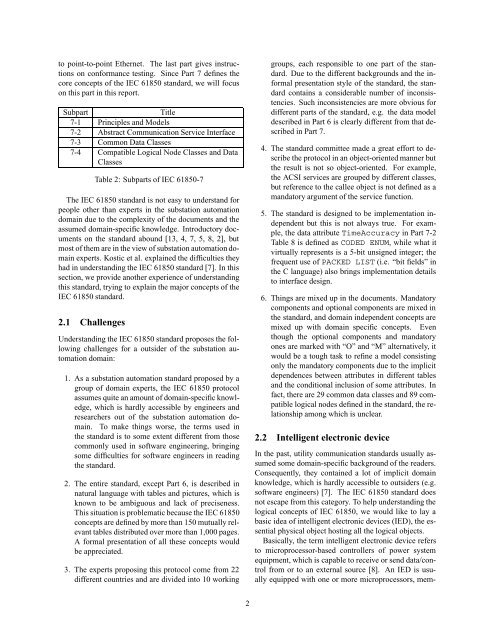Understanding and Simulating the IEC 61850 Standard - CiteSeerX
Understanding and Simulating the IEC 61850 Standard - CiteSeerX
Understanding and Simulating the IEC 61850 Standard - CiteSeerX
Create successful ePaper yourself
Turn your PDF publications into a flip-book with our unique Google optimized e-Paper software.
to point-to-point E<strong>the</strong>rnet. The last part gives instructions<br />
on conformance testing. Since Part 7 defines <strong>the</strong><br />
core concepts of <strong>the</strong> <strong>IEC</strong> <strong>61850</strong> st<strong>and</strong>ard, we will focus<br />
on this part in this report.<br />
Subpart<br />
Title<br />
7-1 Principles <strong>and</strong> Models<br />
7-2 Abstract Communication Service Interface<br />
7-3 Common Data Classes<br />
7-4 Compatible Logical Node Classes <strong>and</strong> Data<br />
Classes<br />
Table 2: Subparts of <strong>IEC</strong> <strong>61850</strong>-7<br />
The <strong>IEC</strong> <strong>61850</strong> st<strong>and</strong>ard is not easy to underst<strong>and</strong> for<br />
people o<strong>the</strong>r than experts in <strong>the</strong> substation automation<br />
domain due to <strong>the</strong> complexity of <strong>the</strong> documents <strong>and</strong> <strong>the</strong><br />
assumed domain-specific knowledge. Introductory documents<br />
on <strong>the</strong> st<strong>and</strong>ard abound [13, 4, 7, 5, 8, 2], but<br />
most of <strong>the</strong>m are in <strong>the</strong> view of substation automation domain<br />
experts. Kostic et al. explained <strong>the</strong> difficulties <strong>the</strong>y<br />
had in underst<strong>and</strong>ing <strong>the</strong> <strong>IEC</strong> <strong>61850</strong> st<strong>and</strong>ard [7]. In this<br />
section, we provide ano<strong>the</strong>r experience of underst<strong>and</strong>ing<br />
this st<strong>and</strong>ard, trying to explain <strong>the</strong> major concepts of <strong>the</strong><br />
<strong>IEC</strong> <strong>61850</strong> st<strong>and</strong>ard.<br />
2.1 Challenges<br />
<strong>Underst<strong>and</strong>ing</strong> <strong>the</strong> <strong>IEC</strong> <strong>61850</strong> st<strong>and</strong>ard proposes <strong>the</strong> following<br />
challenges for a outsider of <strong>the</strong> substation automation<br />
domain:<br />
1. As a substation automation st<strong>and</strong>ard proposed by a<br />
group of domain experts, <strong>the</strong> <strong>IEC</strong> <strong>61850</strong> protocol<br />
assumes quite an amount of domain-specific knowledge,<br />
which is hardly accessible by engineers <strong>and</strong><br />
researchers out of <strong>the</strong> substation automation domain.<br />
To make things worse, <strong>the</strong> terms used in<br />
<strong>the</strong> st<strong>and</strong>ard is to some extent different from those<br />
commonly used in software engineering, bringing<br />
some difficulties for software engineers in reading<br />
<strong>the</strong> st<strong>and</strong>ard.<br />
2. The entire st<strong>and</strong>ard, except Part 6, is described in<br />
natural language with tables <strong>and</strong> pictures, which is<br />
known to be ambiguous <strong>and</strong> lack of preciseness.<br />
This situation is problematic because <strong>the</strong> <strong>IEC</strong> <strong>61850</strong><br />
concepts are defined by more than 150 mutually relevant<br />
tables distributed over more than 1,000 pages.<br />
A formal presentation of all <strong>the</strong>se concepts would<br />
be appreciated.<br />
3. The experts proposing this protocol come from 22<br />
different countries <strong>and</strong> are divided into 10 working<br />
groups, each responsible to one part of <strong>the</strong> st<strong>and</strong>ard.<br />
Due to <strong>the</strong> different backgrounds <strong>and</strong> <strong>the</strong> informal<br />
presentation style of <strong>the</strong> st<strong>and</strong>ard, <strong>the</strong> st<strong>and</strong>ard<br />
contains a considerable number of inconsistencies.<br />
Such inconsistencies are more obvious for<br />
different parts of <strong>the</strong> st<strong>and</strong>ard, e.g. <strong>the</strong> data model<br />
described in Part 6 is clearly different from that described<br />
in Part 7.<br />
4. The st<strong>and</strong>ard committee made a great effort to describe<br />
<strong>the</strong> protocol in an object-oriented manner but<br />
<strong>the</strong> result is not so object-oriented. For example,<br />
<strong>the</strong> ACSI services are grouped by different classes,<br />
but reference to <strong>the</strong> callee object is not defined as a<br />
m<strong>and</strong>atory argument of <strong>the</strong> service function.<br />
5. The st<strong>and</strong>ard is designed to be implementation independent<br />
but this is not always true. For example,<br />
<strong>the</strong> data attribute TimeAccuracy in Part 7-2<br />
Table 8 is defined as CODED ENUM, while what it<br />
virtually represents is a 5-bit unsigned integer; <strong>the</strong><br />
frequent use of PACKED LIST (i.e. “bit fields” in<br />
<strong>the</strong> C language) also brings implementation details<br />
to interface design.<br />
6. Things are mixed up in <strong>the</strong> documents. M<strong>and</strong>atory<br />
components <strong>and</strong> optional components are mixed in<br />
<strong>the</strong> st<strong>and</strong>ard, <strong>and</strong> domain independent concepts are<br />
mixed up with domain specific concepts. Even<br />
though <strong>the</strong> optional components <strong>and</strong> m<strong>and</strong>atory<br />
ones are marked with “O” <strong>and</strong> “M” alternatively, it<br />
would be a tough task to refine a model consisting<br />
only <strong>the</strong> m<strong>and</strong>atory components due to <strong>the</strong> implicit<br />
dependences between attributes in different tables<br />
<strong>and</strong> <strong>the</strong> conditional inclusion of some attributes. In<br />
fact, <strong>the</strong>re are 29 common data classes <strong>and</strong> 89 compatible<br />
logical nodes defined in <strong>the</strong> st<strong>and</strong>ard, <strong>the</strong> relationship<br />
among which is unclear.<br />
2.2 Intelligent electronic device<br />
In <strong>the</strong> past, utility communication st<strong>and</strong>ards usually assumed<br />
some domain-specific background of <strong>the</strong> readers.<br />
Consequently, <strong>the</strong>y contained a lot of implicit domain<br />
knowledge, which is hardly accessible to outsiders (e.g.<br />
software engineers) [7]. The <strong>IEC</strong> <strong>61850</strong> st<strong>and</strong>ard does<br />
not escape from this category. To help underst<strong>and</strong>ing <strong>the</strong><br />
logical concepts of <strong>IEC</strong> <strong>61850</strong>, we would like to lay a<br />
basic idea of intelligent electronic devices (IED), <strong>the</strong> essential<br />
physical object hosting all <strong>the</strong> logical objects.<br />
Basically, <strong>the</strong> term intelligent electronic device refers<br />
to microprocessor-based controllers of power system<br />
equipment, which is capable to receive or send data/control<br />
from or to an external source [8]. An IED is usually<br />
equipped with one or more microprocessors, mem-<br />
2
















